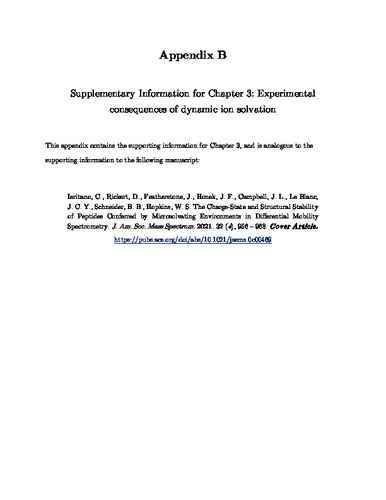| dc.description.abstract | This PhD thesis, titled “Towards Understanding Differential Ion Mobility Spectrometry and its Applications in Analytical and Medicinal Chemistry,” encompasses a broad effort to understand the principles that underpin differential mobility spectrometry (DMS), and how the DMS technique can be employed within the analytical and medicinal facets of chemistry. Specifically, this work highlights the components of the ion-neutral interaction potential that are pertinent to rationalize an ion’s DMS behaviour and how such information can be modelled using in silico and machine-learning approaches. Understanding the nature of ion-neutral interactions is especially important when DMS experiments are conducted in microsolvating environments (i.e., those in which the carrier gas is seeded with small amounts of a volatile solvent vapour), as components of the interaction potential can be used to predict molecular properties that are routinely screened during drug discovery. In the Chapter 1, we introduce the ion-solvent interactions that are intrinsic to DMS experiments and how microsolvation can impact an ion’s mobility. We specifically emphasize the significance of ion solvent clusters and how the waveform used in DMS separations fosters a dynamic solvation environment. Because field-induced heating is modulated such that an analyte undergoes many cycles of solvent condensation and evaporation at charge-dense regions of the analyte, DMS effectively samples interactions that may resemble the dynamics of solvation within the analyte’s primary solvation shell. In this regard, DMS can be utilized to probe characteristics of a molecule related to its insipient solvation, which, when used in conjunction with quantum-chemical calculations and/or machine learning algorithms, affords accurate predictions of that molecule’s physicochemical properties.
In addition to the information regarding an analyte’s physicochemical properties that can be gleaned from DMS measurements in microsolvating environments (Chapter 2), ion microsolvation can help alleviate complications related to field-induced heating. This phenomenon is explored in Chapter 3, where microsolvation was found to stabilize analytes through the formation of localized ion-solvent clusters. In particular, the chapter explores the DMS behaviour of the MP1 peptide, which, when exposed to a microsolvation partner, underwent chemical transformations that reduced the observed charge state of MP1 from [MP1 + 3H]3+ to [MP1 + 2H]2+, and shielded protonated MP1 from fragmentation induced by collisional activation within the DMS cell. This behaviour suggests that microsolvation provides analytes with a solvent “air-bag,” which could play a role in retaining native-like ion configurations during DMS separations that operate well above the low-field limit.
Chapter 4, titled Protonation-Induced Chirality Drives Separation by DMS, explores a fascinating phenomenon that can be probed by DMS. In short, chiral species possessing a permanent stereocenter and a prochiral, tertiary amine can form two diastereomers upon protonation during electrospray ionization. The resulting diastereomers exhibit distinct conformations that are resolvable by DMS, constituting the first measurement of this behaviour in the gas phase. Protonation-induced chirality appears to be a general phenomenon, as N-protonation at the tertiary amino moiety of 13 chiral compounds that contained a prochiral, tertiary amine moiety. The analytical utility of DMS is further exemplified in Chapter 5, where DMS and tandem mass spectrometry (MS) were used to distinguish a set of seven cannabinoids. Detection of analytes as argentinated species (i.e., [M + Ag]+ adducts) also led to the discovery that argentination promotes distinct fragmentation patterns for each cannabinoid, enabling their partial distinction by tandem-MS. By adding DMS to the tandem-MS workflow, each cannabinoid was resolved in a pure N2 DMS environment, allowing for accurate assessment of cannabinoid levels within commercial products with excellent accuracy and limits of detection/quantitation.
In addition to the analytical utility provided by DMS and the other ion mobility spectrometry (IMS) techniques, IMS-based separation prior to mass spectrometry has become an invaluable tool in the structural elucidation of gas phase ions and in the characterization of complex mixtures. Application of ion mobility to structural studies requires an accurate methodology to bridge theoretical modelling of chemical structure with experimental determination of an ion’s collision cross section (CCS). Chapter 6 discusses the software package MobCal-MPI, which was developed to calculate CCSs efficiently and accurately at arbitrary field strengths via the trajectory method, including those accessed during DMS experiments. While significant progress has been made towards modelling the phenomenon of differential mobility, there are still several properties that have yet to be captured by in silico models. This thesis concludes with Chapter 7, which outlines unresolved issues in the field and suggests several directions in which future research endeavours can be directed. | en |





